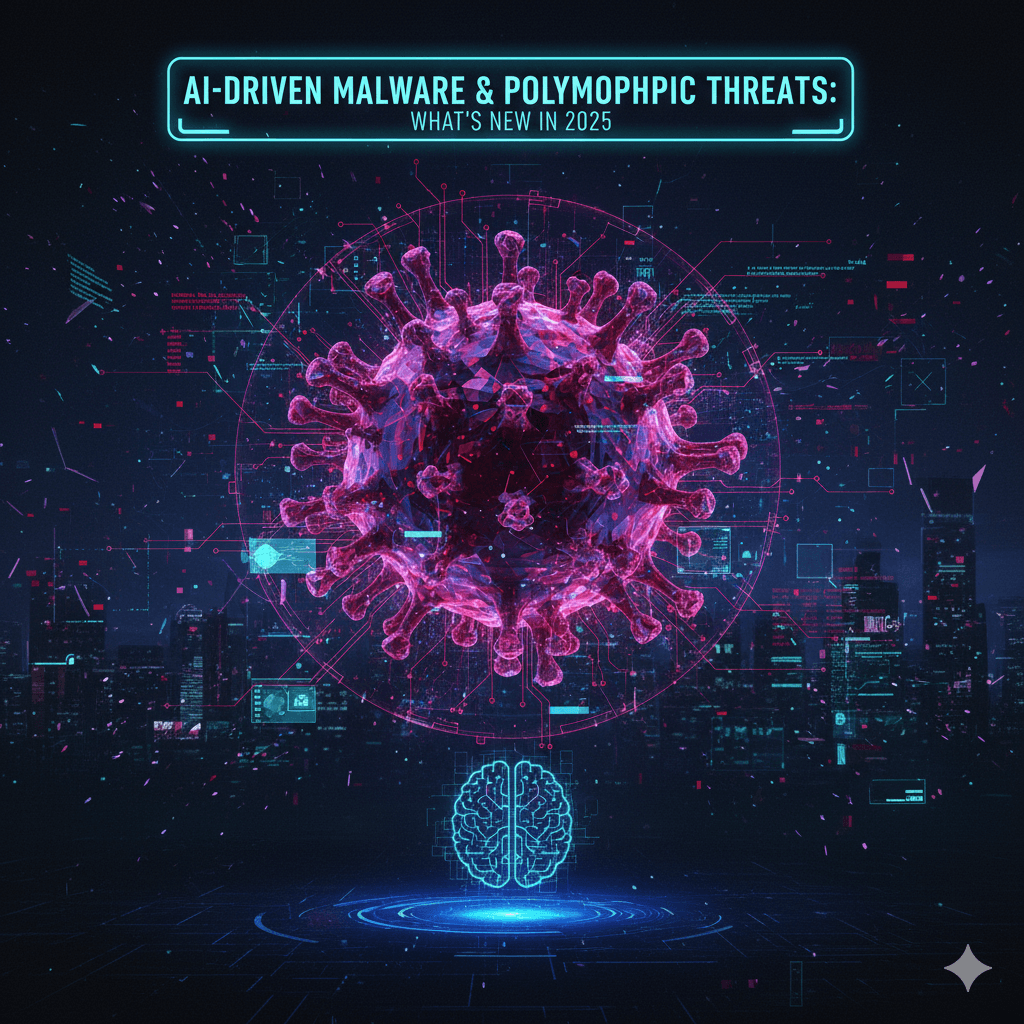In 2025, the cybersecurity landscape is rapidly evolving. Attackers are no longer relying on static malware; they are using AI-driven malware, polymorphic threats, and advanced evasion techniques to slip past traditional defenses. For organizations like yours, staying ahead means understanding these threats — and building more adaptive, intelligent defenses.
Trending keywords: AI malware 2025, polymorphic malware trends, adaptive cybersecurity, next-gen threat detection, cyber threat intelligence.
1. What Are Polymorphic Threats & AI-Driven Malware?

- Polymorphic malware refers to malicious software that changes its code or appearance (signature) each time it infects a new system, making detection by signature-based antivirus tools much harder.
- AI-driven malware means malware using artificial intelligence, machine learning, or generative/adversarial techniques to adapt, evade detection, or even make autonomous decisions during an attack. Exabytes Malaysia+2Reelmind+2
These threats often combine: malware that mutates its code (polymorphism) while also using AI to decide when and how to strike. That intersection is where many new challenges lie. Medium+1
2. What’s New in 2025: Key Trends
Here are some of the most important developments in AI-driven malware & polymorphic threats this year:
| Trend | Description | Implications for Defence |
|---|---|---|
| Self-Mutating / Behavior-Aware Malware | Malware now alters structure, payloads, or behavior depending on environment and defensive tools present (antivirus, EDR, sandbox). It may pause, detour, or adjust itself to avoid detection. Exabytes Malaysia+1 | Security tools must go beyond signature matching to behavioral & anomaly detection. Real-time monitoring and adaptive responses are essential. |
| AI-Powered Phishing & Social Engineering | Attackers use generative AI to create hyper-realistic phishing emails, voice deepfakes, business email compromise (BEC). These are personalized, context-aware, and harder to distinguish from legitimate communication. PR Newswire+2Virtual Guardian+2 | Employee awareness training + AI tools that can analyze communication context, detect impersonation, and verify identity. |
| Autonomous Attack Tactics | Some malware makes autonomous decisions: delaying execution if under scrutiny, choosing alternate paths, extracting data only when safe, etc. Exabytes Malaysia+1 | Launch proactive threat hunting, improve defensive automation, implement layers of detection that can see both overt and latent malicious behavior. |
| Democratization of Malicious AI Tools | More actors — even with modest skills — now have access to “dark” AI tools (jailbroken LLMs, AI malware-kits) to assist in creation of malware, phishing, impersonations. info.ke-la.com+1 | The barrier to launching sophisticated attacks is lowering. Organizations must assume attackers may use automated tooling and anticipate novel attack patterns. |
| Polymorphic Phishing Campaigns | Phishing emails & campaigns that adapt: subject lines, sender names, content vary slightly, so bulk filters miss them. Combined with AI, success rates of phishing rise. SecurityWeek+1 | Anti-phishing solutions need to use behavior, reputation, anomaly detection rather than just static rules. |
3. Case Study & Real-World Example: PromptLock
One of the emerging threats in 2025 is PromptLock — believed to be the first AI-powered ransomware that uses a locally running Large Language Model (LLM) to generate and mutate code dynamically. It evades heuristic detection and API tracking by altering its behavior, payloads, and execution paths depending on the environment. Tom’s Hardware
This type of malware showcases how AI + polymorphism together become a powerful threat: it’s not just what the malware does, but when and how it decides to act. The defenders’ tools must likewise be flexible, contextual, and intelligent.
4. Challenges for Cybersecurity in 2025
- Detection Difficulty: Signature-based methods are increasingly ineffective. Polymorphic malware frequently changes enough that static signatures are outdated before they can be updated.
- False Positives & Negatives: Behavioral/anomaly detection may catch many threats but also may generate false alarms, or miss adaptive threats that carefully mimic normal behavior.
- Resource / Expertise Gaps: Crafting, training, and updating ML/AI models for defense require skilled personnel and computational resources. SMEs are at risk. Something reported is that small-medium organizations are increasingly being targeted due to weaker defenses. PR Newswire+1
- Latency in Response: Because adaptive malware may wait for specific conditions or sit dormant, detection + response must be continuous; delays increase damage.
5. Best Practices & How IT Artificer Can Help
To stay ahead of AI-driven malware & polymorphic threats, here are recommended practices — and how IT Artificer can support:
- Behavior-based & Anomaly Detection Systems
Deploy tools that monitor behavior patterns rather than depending solely on signatures. Use machine learning / AI to spot unusual activity (file access, process behavior, network traffic). - Endpoint Detection & Response (EDR) + Next-Gen Antivirus
Use EDR solutions that incorporate ML models to adapt and respond dynamically. Regularly update these tools to incorporate threat intelligence feeds. - Threat Intelligence & Monitoring
Stay updated with the latest malware sample analyses, AI threats, polymorphic tactics. Continually analyze threat reports and adjust defensive posture. - Automated Response & Orchestration
Automate containment once a threat is detected: isolate affected systems, disable certain user rights, revoke access — reduce dwell time. - Employee Training & Phishing Simulations
Because attackers are using AI to mimic company communication more convincingly, train staff to verify unexpected requests, use two-factor/multi-factor authentication, recognize impostor cues. - Robust Backup & Incident Recovery Plans
Since ransomware such as PromptLock or hybrid attacks may damage / encrypt data, maintain clean backups, test recovery plans, implement fail-safes. - Regular Audits & Security Posture Assessments
Have experts test systems for weaknesses: penetration testing, phishing campaigns, red team exercises, vulnerability scanning.
Contact IT Artificer
Website:itartificer.com
Email:info@itartificer.com
Phone: 0333-9296314





